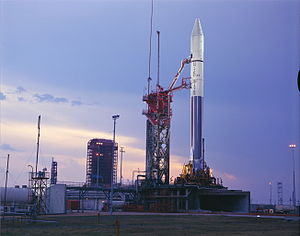- Spaceport Florida Launch Complex 36
-
Launch Complex 36 
An Atlas-Centaur at LC-36 prior to the launch of Pioneer 10Launch site CCAFS (1962-2010)
Spaceport Florida (2010—)Location 28.470417°N
80.539978°WShort name SLC-36 Operator Space Florida
Formerly:NASA
US Air ForceTotal launches 145 Launch pad(s) 2 Minimum / maximum
orbital inclination28° - 57° LC-36A launch history Status Inactive Launches 69 First launch Atlas-Centaur, 18 May 1962 Last launch SDS-3, 31 August 2004 Associated rockets Atlas
Atlas IILC-36B launch history Status Inactive Launches 76 First launch Atlas-Centaur, 11 August 1965 Last launch NOSS-3, 3 February 2005 Associated rockets Atlas
Atlas II
Atlas IIILaunch Complex 36 (LC-36), known as Space Launch Complex 36 (SLC-36) from 1997 to 2010, is a launch complex at Cape Canaveral Air Force Station in Brevard County, Florida. Now operated under license by Space Florida, it was used for Atlas launches from 1962 until 2005.[1][2] The complex consisted of two pads, SLC-36A and -36B, and was the launch site for the Pioneer, Surveyor, and Mariner probes.[3] There were 69 and 76 launches from pads 36A and 36B, respectively. The Atlas rockets launched from Complex 36 were replaced by the Atlas V launches from Complex 41 at Cape Canaveral.
In March 2010, the USAF 45th Space Wing issued Real Property Licenses to Space Florida for Space Launch Complexes 36 and 46 at Cape Canaveral Air Force Station.[4][5]
Contents
Demolition
The umbilical towers of both pads were demolished during the autumn of 2006.[6] The mobile service towers were both demolished in controlled explosions on June 16, 2007. Tower B was demolished at 13:59 GMT (09:59 EDT) and tower A followed twelve minutes later at 14:11 (10:11 EDT).[7]
The MSS of Space Launch Complex 36A falls to the ground after critical supports are destroyed in a controlled explosion. (NASA)See also
References
- ^ McDowell, Jonathan (February 22, 1998). "Issue 350". Jonathan's Space Report. Jonathan's Space Page. http://planet4589.org/space/jsr/back/news.350. Retrieved January 25, 2010.
- ^ "Table 3 — Launch Capability in Florida". AU-18 Space Handbook. Air War College Gateway to the Internet. http://www.au.af.mil/au/awc/awcgate/au-18/au180051.htm. Retrieved January 25, 2010.
- ^ Research Triangle Institute, Center for Aerospace Technology (CAST), Florida Office (March 1999). "Launch Site Safety Assessment, Section 1.0 Eastern Range General Range Capabilities" (PDF). Federal Aviation Administration. p. 31. http://www.fas.org/spp/military/facility/99mar_ccas_1.pdf. Retrieved January 25, 2010.
- ^ "Air Force licenses two launch complexes for commercial use". http://www.patrick.af.mil/news/story.asp?id=123194543. Retrieved March 15, 2010.
- ^ "Space Florida secures licenses for Launch Complexes 46 and 36". http://www.spaceflorida.gov/index.php/en/news/37-news/192-space-florida-secures-licenses-for-launch-complexes-46-and-36. Retrieved March 15, 2010.
- ^ Coledan, Stefano S. (February 28, 2006). "Slowly Crumbling, NASA Landmarks May Face the Bulldozer". The New York Times (Cape Canaveral: The New York Times). http://www.nytimes.com/2006/02/28/science/space/28merc.html. Retrieved January 25, 2010.
- ^ Warren, Ken (June 21, 2007). "Historic complex 36 towers toppled". Air Force (Patrick Air Force Base: 45th SW Public Affairs). http://www.patrick.af.mil/news/story_print.asp?id=123058078. Retrieved January 25, 2010.
External links
Coordinates: 28°28′14″N 80°32′24″W / 28.470417°N 80.539978°W
Cape Canaveral and Merritt Island launch sites Atlantic Missile Range drop zone • Grand Turk Island drop zone • Mobile Launch Area • SLBM Launch Area • Patrick AFB • Shuttle Landing Facility • Cape Canaveral AFS Skid StripCategories:- Buildings and structures in Brevard County, Florida
- Cape Canaveral Air Force Station
- Rocketry stubs
Wikimedia Foundation. 2010.


